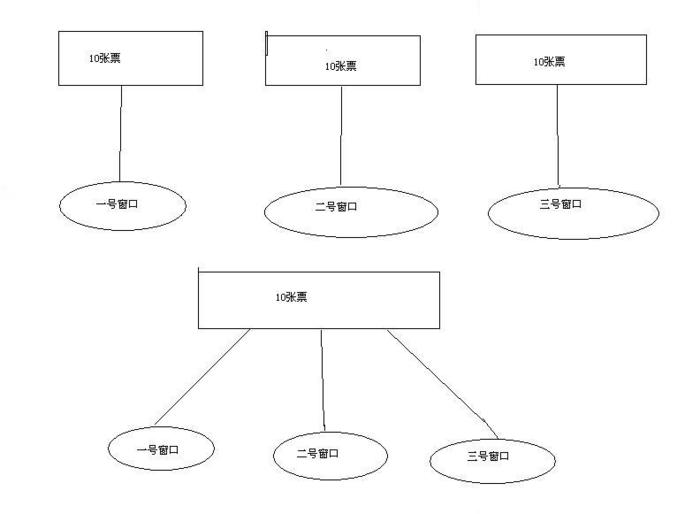Java的兩種多線程實現方式
##一、創建多線程的兩種方式 Java中,有兩種方式可以創建多線程:
1 通過繼承Thread類,重寫Thread的run()方法,將線程運行的邏輯放在其中
2 通過實現Runnable接口,實例化Thread類 在實際應用中,我們經常用到多線程,如車站的售票系統,車站的各個售票口相當於各個線程。當我們做這個系統的時候可能會想到兩種方式來實現,繼承Thread類或實現Runnable接口,現在看一下這兩種方式實現的兩種結果。
程序1:
class MyThread extends Thread
{
private int ticket = 10;
private String name;
public MyThread(String name)
{
this.name = name;
}
public void run()
{
for (int i = 0; i < 500; i++) {
if (this.ticket > 0) {
System.out.println(this.name + "賣票---->" + (this.ticket--));
}
}
}
}
public class ThreadDemo
{
public static void main(String[] args)
{
MyThread mt1 = new MyThread("一號窗口");
MyThread mt2 = new MyThread("二號窗口");
MyThread mt3 = new MyThread("三號窗口");
mt1.start();
mt2.start();
mt3.start();
}
}
運行結果:
一號窗口賣票---->10
三號窗口賣票---->10
二號窗口賣票---->10
三號窗口賣票---->9
三號窗口賣票---->8
三號窗口賣票---->7
一號窗口賣票---->9
三號窗口賣票---->6
二號窗口賣票---->9
三號窗口賣票---->5
一號窗口賣票---->8
三號窗口賣票---->4
二號窗口賣票---->8
三號窗口賣票---->3
一號窗口賣票---->7
三號窗口賣票---->2
二號窗口賣票---->7
三號窗口賣票---->1
一號窗口賣票---->6
一號窗口賣票---->5
一號窗口賣票---->4
一號窗口賣票---->3
二號窗口賣票---->6
一號窗口賣票---->2
二號窗口賣票---->5
一號窗口賣票---->1
二號窗口賣票---->4
二號窗口賣票---->3
二號窗口賣票---->2
程序2:
class MyThread1 implements Runnable
{
private int ticket = 10;
public void run()
{
for (int i = 0; i < 500; i++) {
if (this.ticket > 0) {
System.out.println(Thread.currentThread().getName()
+ "賣票---->" + (this.ticket--));
}
}
}
}
public class RunnableDemo {
public static void main(String[] args)
{
// 設計三個線程
MyThread1 mt = new MyThread1();
Thread t1 = new Thread(mt, "一號窗口");
Thread t2 = new Thread(mt, "二號窗口");
Thread t3 = new Thread(mt, "三號窗口");
t1.start();
t2.start();
t3.start();
}
}
運行結果:
一號窗口賣票---->10
二號窗口賣票---->8
二號窗口賣票---->6
二號窗口賣票---->5
三號窗口賣票---->9
二號窗口賣票---->4
一號窗口賣票---->7
二號窗口賣票---->2
三號窗口賣票---->3
一號窗口賣票---->1
為什麼兩個程序的結果不同呢?
第1個程序,相當於拿出三件事即三個賣票10張的任務分別分給三個窗口,他們各做各的事各賣各的票各完成各的任務,因為MyThread繼承Thread類,所以在new MyThread的時候在創建三個對象的同時創建了三個線程。
第2個程序,相當於是拿出一個賣票10張得任務給三個人去共同完成,new MyThread相當於創建一個任務,然後實例化三個Thread,創建三個線程即安排三個窗口去執行。
用圖表示如下:
通過上面的分析,我們發現這兩種多線程有兩大區別:
(1) Thread方式是繼承;Runnable方式是實現接口。
(2) Thread方式是多個線程分別完成自己的任務,即數據獨立;Runnable方式是多個線程共同完成一個任務,即數據共享。
大多數情況下,如果只想重寫run() 方法,而不重寫其他 Thread 方法,那麼應使用 Runnable 接口。這很重要,因為除非程序員打算修改或增強類的基本行為,否則不應為該類(Thread)創建子類。
##二、隱藏的問題
在第二種方法中,由於3個Thread對象共同執行一個Runnable對象中的代碼,因此可能會造成線程的不安全,比如可能ticket會輸出-1(如果我們System.out....語句前加上線程休眠操作,該情況將很有可能出現)。
這種情況的出現是由於,一個線程在判斷ticket為1>0後,還沒有來得及減1,另一個線程已經將ticket減1,變為了0,那麼接下來之前的線程再將ticket減1,便得到了-1。
這就需要加入同步操作(即互斥鎖),確保同一時刻只有一個線程在執行每次for循環中的操作。
而在第一種方法中,並不需要加入同步操作,因為每個線程執行自己Thread對象中的代碼,不存在多個線程共同執行同一個方法的情況。
程序1:
class MyThread1 implements Runnable
{
private int ticket = 10;
public void run()
{
for (int i = 0; i < 500; i++) {
if (this.ticket > 0) {
try {
Thread.sleep(100);
System.out.println(Thread.currentThread().getName()
+ "賣票---->" + (this.ticket--));
} catch (Exception e) {
e.printStackTrace();
}
}
}
}
}
public class RunnableDemo {
public static void main(String[] args)
{
// 設計三個線程
MyThread1 mt = new MyThread1();
Thread t1 = new Thread(mt, "一號窗口");
Thread t2 = new Thread(mt, "二號窗口");
Thread t3 = new Thread(mt, "三號窗口");
t1.start();
t2.start();
t3.start();
}
}
運行結果:
三號窗口賣票---->10
一號窗口賣票---->10
二號窗口賣票---->10
三號窗口賣票---->9
一號窗口賣票---->8
二號窗口賣票---->7
三號窗口賣票---->6
一號窗口賣票---->5
二號窗口賣票---->4
三號窗口賣票---->3
一號窗口賣票---->2
二號窗口賣票---->1
三號窗口賣票---->0
注意,這裡的10張票都是一號窗口賣出的。這是因為用了synchronized並且票數太少了,在t1對this對象鎖定的時間內,10張票就已經被賣完了。輪到t2或t3鎖定this對象時,已經無票可賣了。如果票數多一點,比如有幾萬張,就可以看到三個窗口都參與了賣票。
程序2:
class MyThread1 implements Runnable
{
private int ticket = 1000;
public void run()
{
for (int i = 0; i < 5000; i++) {
synchronized(this) {
if (this.ticket > 0) {
System.out.println(Thread.currentThread().getName() + "賣票---->" +
(this.ticket--));
}
}
}
}
}
public class RunnableDemo {
public static void main(String[] args)
{
// 設計三個線程
MyThread1 mt = new MyThread1();
Thread t1 = new Thread(mt, "一號窗口");
Thread t2 = new Thread(mt, "二號窗口");
Thread t3 = new Thread(mt, "三號窗口");
t1.start();
t2.start();
t3.start();
}
}
